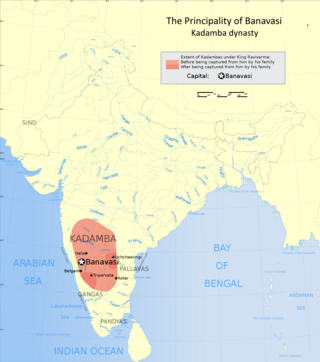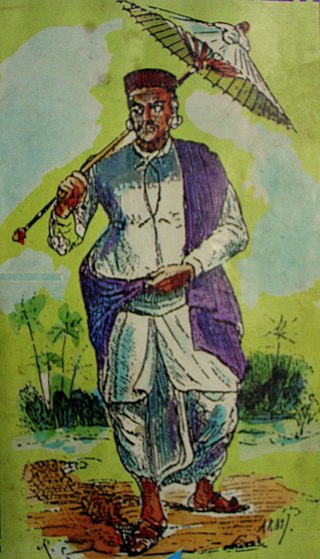Related Research Articles

The middle kingdoms of India were the political entities in the Indian subcontinent from 230 BCE to 1206 CE. The period begins after the decline of the Maurya Empire and the corresponding rise of the Satavahana dynasty, starting with Simuka, from 230 BCE. The "middle" period lasted for almost 1436 years and ended in 1206 CE, with the rise of the Delhi Sultanate, founded in 1206, and the end of the Later Cholas.

The Pratihara dynasty, also called the Gurjara-Pratiharas, the Pratiharas of Kannauj or the Imperial Pratiharas, was a prominent medieval Indian dynasty which ruled over the Kingdom of Kannauj. It initially ruled the Gurjaradesa until its victory in the Tripartite Struggle in 816 which secured its right to the throne of Kannauj. Cadet branches of the dynasty ruled other minor states in the subcontinent.

The history of Goa dates back to prehistoric times, though the present-day state of Goa was only established as recently as 1987. In spite of being India's smallest state by area, Goa's rich history is both long and diverse. It shares a lot of similarities with Indian history, especially with regard to colonial influences and a multi-cultural aesthetic.

The Kadambas were an ancient royal family from modern Karnataka, India, that ruled northern Karnataka and the Konkan from Banavasi in present-day Uttara Kannada district in India. The kingdom was founded by Mayurasharma in c. 345, and at later times showed the potential of developing into imperial proportions. An indication of their imperial ambitions is provided by the titles and epithets assumed by its rulers, and the marital relations they kept with other kingdoms and empires, such as the Vakatakas and Guptas of northern India. Mayurasharma defeated the armies of the Pallavas of Kanchi possibly with the help of some native tribes and claimed sovereignty. The Kadamba power reached its peak during the rule of Kakusthavarma.

The Satavahanas, also referred to as the Andhras in the Puranas, were an ancient Indian dynasty. Most modern scholars believe that the Satavahana rule began in the late second century BCE and lasted until the early third century CE, although some assign the beginning of their rule to as early as the 3rd century BCE based on the Puranas, but uncorroborated by archaeological evidence. The Satavahana kingdom mainly comprised the present-day Andhra Pradesh, Telangana, and Maharashtra. At different times, their rule extended to parts of modern Gujarat, Madhya Pradesh, and Karnataka. The dynasty had different capital cities at different times, including Kotalingala (Telangana), Pratishthana (Paithan) and Amaravati (Dharanikota).

The Chutu dynasty ruled parts of the Deccan region of South India between first and third centuries CE, with its capital at Banavasi in present-day Karnataka state. The Chutus probably rose to power as Satavahanas feudatories, and assumed sovereignty after the decline of the Satavahana power. Except for the edicts of Asoka, the inscriptions of the Chutu dynasty are the oldest documents found in the northern part of Karnataka State, India.

The Vidarbha kingdom in the Sanskrit epic Mahabharata is among the many kingdoms ruled by Yadu kings . It was situated in the region still known as Vidarbha in what is now Maharashtra in central India.
Kirttivarman I was a ruler of the Chalukya dynasty of Vatapi in India. He ruled parts of present-day Karnataka, Goa, Maharashtra and Andhra Pradesh.

Eastern Chalukyas, also known as the Chalukyas of Vengi, were a dynasty that ruled parts of South India between the 7th and 12th centuries. They started out as governors of the Chalukyas of Badami in the Deccan region. Subsequently, they became a sovereign power, and ruled the Vengi region of present-day Andhra Pradesh until c. 1001 CE. They continued ruling the region as feudatories of the Medieval Cholas until 1189 CE.

The Seuna, Sevuna, or Yadavas of Devagiri was a medieval Indian dynasty, which at its peak ruled a realm stretching from the Narmada river in the north to the Tungabhadra river in the south, in the western part of the Deccan region. Its territory included present-day Maharashtra, northern Karnataka and parts of Madhya Pradesh, from its capital at Devagiri.
The political history of medieval Karnataka spans the 4th to the 16th centuries in Karnataka region of India. The medieval era spans several periods of time from the earliest native kingdoms and imperialism; the successful domination of the Gangetic plains in northern India and rivalry with the empires of Tamilakam over the Vengi region; and the domination of the southern Deccan and consolidation against Muslim invasion. The origins of the rise of the Karnataka region as an independent power date back to the fourth-century birth of the Kadamba Dynasty of Banavasi which was the earliest of the native rulers to conduct administration in the native language of Kannada in addition to the official Sanskrit.

The Kadambas of Goa were a dynasty during the Late Classical period on the Indian subcontinent, who ruled Goa from the 10th to the 14th century CE. They took over the territories of the Shilaharas and ruled them at first from Chandor, later making Gopakapattana their capital.

Shett is a surname and title of the Daivajna subcaste of Konkani people, residing along the coast of the Konkan region in western India. It is also an honorific used by them in Goa, Damaon, Konkan division of Maharashtra, and Kanara subregion of Karnataka.

The House of Paramara was a prominent Indian Rajput dynasty that ruled over the Kingdom of Malwa, the Garhwal Kingdom, and many other kingdoms, princely states and feudal estates in North India. They belonged to the Parmara clan of the Rajputs.
Buddhism in Northern Karnataka has seen major development after the discovery of an Ashoka inscription at Maski in Raichur District a few decades ago and of a Buddhist settlement through a series of archaeological excavations at Sannati which have shed light on the historic significance of Karnataka.
This article details the history of Raigad district. Raigad District is a district in the Indian state of Maharashtra. It is located in the Konkan region. The Kulaba district was renamed after Raigad, the fort which was the former capital of the Maratha ruler Chatrapati Shivaji Maharaj. The fort is surrounded by dense forest in the interior regions of the district, on a west-facing spur of the Western Ghats of Sahyadri range. The name was changed during the regime of Chief Minister A. R. Antulay on 1 January 1981.
Revatidvipa or Govapuri was a province under the Chalukya dynasty, encompassing parts of modern-day Goa and Maharashtra, India. Revatidvipa was an important trading port of the dynasties that controlled it, including the Chalukyas. It was conquered by the Rashtrakuta ruler Krishna I in 753 AD.

The Bhoja tribes were a collection of semi-Aryan ancient tribes, located in India during the Late Vedic Period. They are described as being an offshoot of the Yadava tribe in the Indian epic of Mahabharata. They were a branch of the Andhaka clan, who were in turn descendants of the Satvata clan descended from King Yadu. The Bhojas were sub-divided into eighteen branches and ruled from their capital at Mrittikavati, on the banks of the Parnasa river in Central India.
The Maurya dynasty ruled the coastal Konkan region in present-day Goa and Maharashtra states of India, between the 4th and the 7th centuries. Their capital was Puri, which is variously identified as Gharapuri (Elephanta), Salsette, or Rajapuri. The dynasty is known only from a few records, and there is very little clarity on its genealogy, chronology, territory, administration and political status.
Devaraja was the founder of the Bhoja dynasty, which ruled over the region of Goa and other parts of western India from the 3rd to the 6th century CE.
References
- Epigraphia Indica, (Volume XXXVII, XXVI)